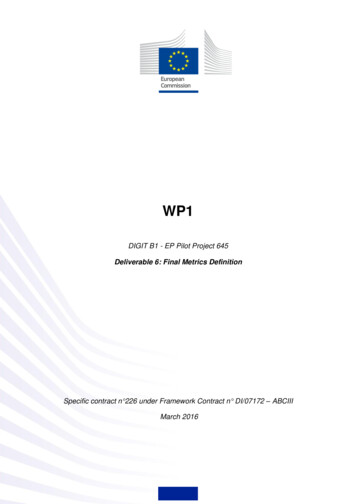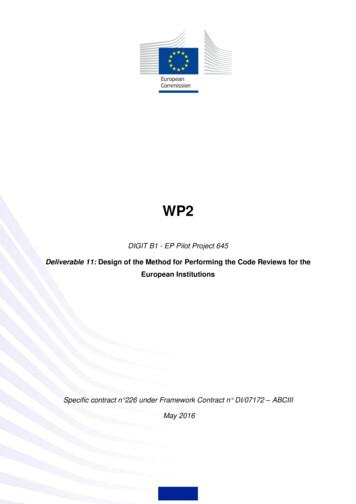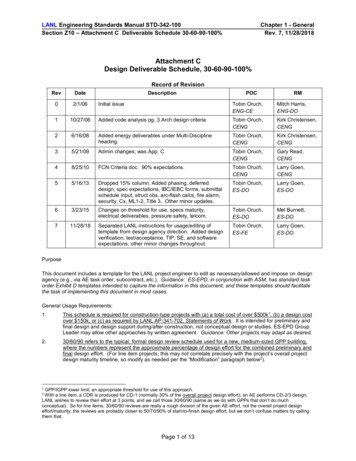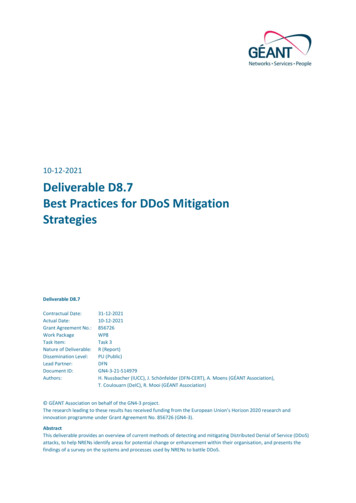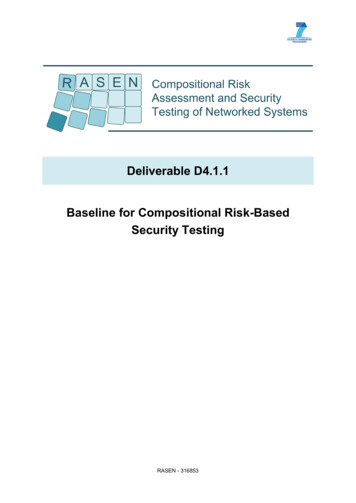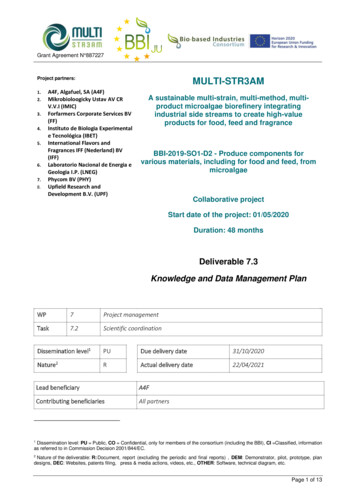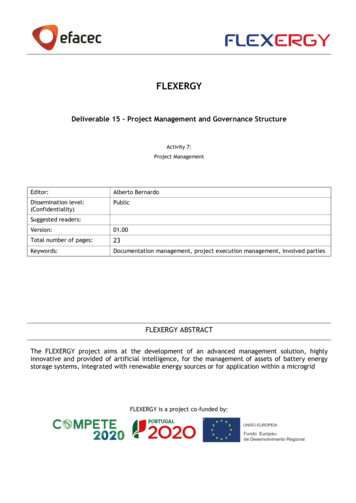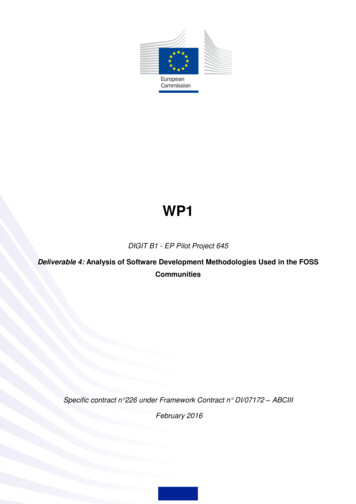
Transcription
WP1DIGIT B1 - EP Pilot Project 645Deliverable 4: Analysis of Software Development Methodologies Used in the FOSSCommunitiesSpecific contract n 226 under Framework Contract n DI/07172 – ABCIIIFebruary 2016
DIGIT Fossa WP1 – Governance and Quality of Software Code – Auditing of Free and Open SourceSoftware.Deliverable 4: Analysis of Software Development Methodologies Used in the FOSS CommunitiesAuthor:DisclaimerThe information and views set out in this publication are those of the author(s) and do not necessarilyreflect the official opinion of the Commission. The content, conclusions and recommendations set out inthis publication are elaborated in the specific context of the EU – FOSSA project.The Commission does not guarantee the accuracy of the data included in this study. All representations,warranties, undertakings and guarantees relating to the report are excluded, particularly concerning – butnot limited to – the qualities of the assessed projects and products. Neither the Commission nor any personacting on the Commission’s behalf may be held responsible for the use that may be made of theinformation contained herein. European Union, 2016.Reuse is authorised, without prejudice to the rights of the Commission and of the author(s), provided thatthe source of the publication is acknowledged. The reuse policy of the European Commission isimplemented by a Decision of 12 December 2011.Document elaborated in the specific context of the EU – FOSSA project.Reuse or reproduction authorised without prejudice to the Commission’s or the authors’ rights.Page 2 of 146
DIGIT Fossa WP1 – Governance and Quality of Software Code – Auditing of Free and Open SourceSoftware.Deliverable 4: Analysis of Software Development Methodologies Used in the FOSS CommunitiesContentsCONTENTS. 3LIST OF TABLES . 6LIST OF FIGURES . 7ACRONYMS AND ABBREVIATIONS . 812INTRODUCTION . 91.1.OBJECTIVE OF THIS DOCUMENT AND INTENDED AUDIENCE . 91.2.SCOPE . 91.3.DOCUMENT STRUCTURE . 91.4.KEY SUCCESS FACTORS . 101.5.DELIVERABLES . 10METHODOLOGICAL APPROACH TO BUILDING THE ANALYSIS . 112.1.SELECTION OF PROJECTS, ENGAGEMENT WITH FREE AND OPEN SOURCE SOFTWARE COMMUNITIESAND INFORMATION GATHERING . 1132.2.INFORMATION CLASSIFICATION AND FILTERING PROCESS . 122.3.ANALYSIS OF THE INFORMATION . 12SOFTWARE DEVELOPMENT METHODOLOGIES, BEST PRACTICES, FRAMEWORKS,LIBRARIESAND TOOLS USED IN THE PROJECTSANALYSED FROM THE FOSSCOMMUNITIES . 143.1.METHODOLOGIES USED BY THE ANALYSED FOSS COMMUNITIES DURING THE SOFTWAREDEVELOPMENT LIFECYCLE. 153.2.BEST PRACTICES USED BY THE ANALYSED FOSS COMMUNITIES DURING THE SOFTWAREDEVELOPMENT LIFECYCLE. 193.3.TOOLS USED BY THE ANALYSED FOSS COMMUNITIES DURING THE SOFTWARE DEVELOPMENTLIFECYCLE . 743.4.LIBRARIES AND BUILDING BLOCKS USED BY THE ANALYSED FOSS COMMUNITIES DURING THESOFTWARE DEVELOPMENT LIFECYCLE . 1103.5.PROGRAMMING LANGUAGES USED BY THE ANALYSED FOSS COMMUNITIES DURING THE SOFTWAREDEVELOPMENT LIFECYCLE. 1164ANALYSIS OF IDENTIFIED SOFTWARE DEVELOPMENT METHODOLOGIES USED IN FOSSCOMMUNITIES . 1224.1.PROJECT MANAGEMENT . 123Document elaborated in the specific context of the EU – FOSSA project.Reuse or reproduction authorised without prejudice to the Commission’s or the authors’ rights.Page 3 of 146
DIGIT Fossa WP1 – Governance and Quality of Software Code – Auditing of Free and Open SourceSoftware.Deliverable 4: Analysis of Software Development Methodologies Used in the FOSS Communities4.1.1.Methodologies . 1234.1.2.Conclusion . 1254.2.SOFTWARE DEVELOPMENT LIFECYCLE . 1254.2.1.Software Development Lifecycle Methodologies . 1254.2.1.1.Methodologies . 1254.2.1.2.Tools . 1264.2.1.3.Conclusion . 1274.2.2.Security Definition . 1274.2.2.1.Security Requirements . 1274.2.2.2.Security Awareness . 1284.2.2.3.Conclusion . 1304.2.3.Testing and Validation . 1304.2.3.1.Automatic Testing . 1314.2.3.2.Security Testing . 1314.2.3.3.Validation Testing. 1324.2.3.4.Tools and Methods. 1324.2.4.Release Management . 1324.2.4.1.Conclusion . 1334.2.4.2.Release Planning . 1334.2.4.3.Continuous Testing and Validation . 1334.2.4.4.Channels and Tools Used . 1344.2.4.5.Conclusion . 1344.2.5.Inspection and Code Review . 1354.2.5.1.Code Review . 1354.2.5.2.Tools . 1354.2.5.3.Projects Reviewed by Security Experts . 1364.2.5.4.Phase Where the Project is Reviewed by Security Experts . 1364.2.5.5.Conclusion . 1374.2.6.Application Authentication and Authorisation . 1374.2.6.1.Authentication . 1374.2.6.2.Authorisation . 1384.2.6.3.Conclusion . 1384.3.PROJECT MAINTENANCE . 1394.3.1.Incident Management . 1394.3.1.1.Incident Resolution. 1394.3.1.2.Handling of Major Incidents . 1404.3.1.3.User Notification . 1404.3.1.4.Conclusion . 1404.3.2.Problem Management . 141Document elaborated in the specific context of the EU – FOSSA project.Reuse or reproduction authorised without prejudice to the Commission’s or the authors’ rights.Page 4 of 146
DIGIT Fossa WP1 – Governance and Quality of Software Code – Auditing of Free and Open SourceSoftware.Deliverable 4: Analysis of Software Development Methodologies Used in the FOSS Communities4.3.2.1.Identification of Security Updates or Bugs . 1414.3.2.2.Problem Resolution Plan . 1424.3.2.3.Tools and Resources Used . 1424.3.2.4.Conclusion . 1424.4.FOSS COMMUNITIES, PRIVATE ORGANISATIONS AND EUROPEAN INSTITUTIONS . 1424.5.RELEVANT OPINIONS AND ADVICE FROM INTERVIEWEES . 1445REFERENCES . 1456ANNEXES . 1466.1.QUESTIONNAIRES FOR THE INTERVIEW. 1466.2.EXECUTIVE SUMMARY . 146Document elaborated in the specific context of the EU – FOSSA project.Reuse or reproduction authorised without prejudice to the Commission’s or the authors’ rights.Page 5 of 146
DIGIT Fossa WP1 – Governance and Quality of Software Code – Auditing of Free and Open SourceSoftware.Deliverable 4: Analysis of Software Development Methodologies Used in the FOSS CommunitiesList of TablesTable 1: Project Management Approach.124Table 2: Software Development Management Approach .126Table 3: Security Requirements in FOSS Communities .128Table 4: Security Definition Phase in FOSS Communities .129Table 5: Execution of Risk Assessment in FOSS Communities .129Table 6: Automatic Testing .131Table 7: Security Testing .131Table 8: Roadmap in FOSS Communities .133Table 9: Continuous Integration in FOSS Communities .134Table 10: Code Review in FOSS Communities .135Table 11: Table Regarding Security Experts Review in FOSS Communities .136Table 12: Phase Where Security Experts Review the Code in FOSS Communities .136Table 13: Authentication Modules in FOSS Communities .138Table 14: Authorisation Model in FOSS Communities .138Table 15: Incident Resolution in FOSS Communities .139Table 16: User Notification Channels Used in FOSS Communities .140Table 17: Methods for Identifying Bugs in FOSS Communities .141Table 18: Enterprise Collaboration in FOSS Communities .143Document elaborated in the specific context of the EU – FOSSA project.Reuse or reproduction authorised without prejudice to the Commission’s or the authors’ rights.Page 6 of 146
DIGIT Fossa WP1 – Governance and Quality of Software Code – Auditing of Free and Open SourceSoftware.Deliverable 4: Analysis of Software Development Methodologies Used in the FOSS CommunitiesList of FiguresFigure 1: Methodological approach used to build the analysis - Information sources .12Figure 2: Project Management Approach .123Figure 4: Security Requirements in FOSS Communities .127Figure 5: Security Definition Phase in FOSS Communities .129Document elaborated in the specific context of the EU – FOSSA project.Reuse or reproduction authorised without prejudice to the Commission’s or the authors’ rights.Page 7 of 146
DIGIT Fossa WP1 – Governance and Quality of Software Code – Auditing of Free and Open SourceSoftware.Deliverable 4: Analysis of Software Development Methodologies Used in the FOSS CommunitiesAcronyms and AbbreviationsAPIApplication Programming InterfaceEUIEuropean InstitutionsEPEuropean ParliamentDGDirectorate GeneralDACDiscretionary Access ControlESAPIEnterprise Security Application Programming InterfaceFOSSFree and Open Source SoftwareFOSSAFree and Open Source Software AuditingMACMandatory Access ControlOSOperating SystemRBACRole-based access controlSDLCSystem Development Life CycleSEOSearch Engine OptimizationWPWork PackageDocument elaborated in the specific context of the EU – FOSSA project.Reuse or reproduction authorised without prejudice to the Commission’s or the authors’ rights.Page 8 of 146
DIGIT Fossa WP1 – Governance and Quality of Software Code – Auditing of Free and Open SourceSoftware.Deliverable 4: Analysis of Software Development Methodologies Used in the FOSS Communities1 Introduction1.1. Objective of this Document and Intended AudienceThis document represents the deliverable 4 included within TASK-02: Analysis of software developmentmethodologies used in the Free and Open Source Software – FOSS communities.The objective of this document is to analyse the software development methodologies, tools and bestpractices used in the FOSS communities that were selected and prioritised in Deliverable 2.This document is addressed to the DIGIT and ITEC departments that are interested in reviewing andanalysing the results of the study of the software development methodologies, related practices and toolsused in the FOSS communities, which, together with the results of Deliverable 3, will give them enoughbackground information to understand and review Deliverable 7.1.2. ScopeThe analysis covers the FOSS communities that were selected during the development of Deliverable 2. Toaccomplish this analysis, a representative of the community was interviewed.Throughout the document, the term “FOSS communities” refers to the FOSS projects, communities andfoundations that fall within the defined scope. Red Hat, a private OSS organisation, was included in theanalysis at the request of DIGIT.1.3. Document StructureThis document consists of the following sections: Section 1: Introduction, which describes the objectives of this deliverable, intended audience andScope. Section 2: Methodological Approach to Building the Analysis, which describes the steps that wefollowed to conduct the analysis of the different methodologies, tools and best practices used by theselected FOSS communities, according to the scope. Section 3: Software Development Methodologies, Best Practices and Tools used in the FOSScommunities. Section 4: Analysis of the identified software development methodologies used in FOSScommunities. Section 5: Bibliographical references. Section 6: Annexes.Document elaborated in the specific context of the EU – FOSSA project.Reuse or reproduction authorised without prejudice to the Commission’s or the authors’ rights.Page 9 of 146
DIGIT Fossa WP1 – Governance and Quality of Software Code – Auditing of Free and Open SourceSoftware.Deliverable 4: Analysis of Software Development Methodologies Used in the FOSS Communities1.4. Key Success FactorsAll steps described in Section 2 - Methodological approach to building the analysis, will ensure thefulfilment of key success factors related to this deliverable: Having a complete stock of methodologies used both in the European Institutions and FOSScommunities that were selected for this project. Including a variety of best practises typologies: technical, organisational and about the governanceand quality of free and open source software (e.g.: synchronisation with private organisations;guidelines for secure software development; secure integration and interoperability of differentcomponents; sustainable ways of FOSS governance and professional services). Integrating practical best practices within existing processes, procedures and tools (e.g.: CEVdatabase).1.5.Deliverables1Deliverable 2: Approach Towards the Execution of Task 22Deliverable 3: Analysis of Software Development Methodologies Used in the European Institutions3Deliverable 7: Comparative studyDocument elaborated in the specific context of the EU – FOSSA project.Reuse or reproduction authorised without prejudice to the Commission’s or the authors’ rights.Page 10 of 146
DIGIT Fossa WP1 – Governance and Quality of Software Code – Auditing of Free and Open SourceSoftware.Deliverable 4: Analysis of Software Development Methodologies Used in the FOSS Communities2 MethodologicalApproachtoBuildingtheAnalysisThe goal of this document is to analyse all information gathered during the interviews and researchconducted by everis’ teams that relate to this study. This analysis will provide valuable information fromthe identified FOSS communities in regard to: Software development methodologies in use Best practices in use Tools in use Release management Incident management Security aspects related to software development Their points of view on how European Institutions can contribute to ensure that critical softwarecan be trusted.2.1. Selection of Projects, Engagement with Free and Open SourceSoftware Communities and Information GatheringFor this step, the following activities were conducted: Deliverable 2 provided a list of 14 FOSS communities and organisations to be analysed. In order to engage the communities representatives, everis sent an executive summary explainingthe importance of the FOSSA project, and requesting their availability for an interview to gatherinformation on their particular project, community or organisation. During the interview rounds, 14 out of 15 projects were covered. The everis team of FOSS experts provided information on best practices, methodologies and toolsused by some of the communities. The everis project team researched the communities that were not interviewed, to gatherinformation on their best practices, methodologies and tools.Document elaborated in the specific context of the EU – FOSSA project.Reuse or reproduction authorised without prejudice to the Commission’s or the authors’ rights.Page 11 of 146
DIGIT Fossa WP1 – Governance and Quality of Software Code – Auditing of Free and Open SourceSoftware.Deliverable 4: Analysis of Software Development Methodologies Used in the FOSS Communities2.2. Information Classification and Filtering ProcessThe following figure shows which information sources were used to conduct the analysis.Figure 1: Methodological approach used to build the analysis - Information sourcesInterview Results Documentation AnalysisInterview Results: During the interviews with the representatives of the FOSS communities, weused a questionnaire to obtain the relevant information for the study. Since the interviews wereconducted as an open discussion, the information gathered was filtered and classified to conductthe analysis. For this purpose, a spreadsheet was created to count the number of projects using aspecific methodology, practice or tool under analysis. Common criteria were taken into account,but the particularities of each community were also included, as they could add value to the study.After filtering and classifying the data, each methodology, practice or tool used by a communitywas compared with the ones used by other communities; this allowed the calculation of thepercentage of usage within the communities analysed. This percentage is an indication of howoften the analysed variable is used or followed by the projects selected among the FOSScommunities. Documentation Analysis: In order to complete the information related to the identifiedmethodologies, best practices and tools, public documentation found on the communities’ websiteswas analysed to fulfill the aspects mentioned above. everis’s team of experts also providedinformation for the analysis.2.3. Analysis of the InformationSections 3 and 4 of this document are structured following two main objectives: Software development methodologies, best practices and tools used in the FOSScommunities: For each of the methodologies, best practices and tools gathered from theinterviews, a form is created in order to complete the information about each variable. Analysis of identified software development methodologies, best practices and tools usedin the FOSS communities: This section is structured according to four main points in conductingthe analysis:oProject Management: Analyses the methodologies used within the different phases ofproject management.Document elaborated in the specific context of the EU – FOSSA project.Reuse or reproduction authorised without prejudice to the Commission’s or the authors’ rights.Page 12 of 146
DIGIT Fossa WP1 – Governance and Quality of Software Code – Auditing of Free and Open SourceSoftware.Deliverable 4: Analysis of Software Development Methodologies Used in the FOSS CommunitiesoSoftware Development Lifecycle: Analyses the methodologies, practices and tools usedwithin the different phases of the project development.oProject Maintenance: Analyses the methodologies, practices and tools used to ensurethe sustainability of the projects and their quality.oHow European Institutions contribute to FOSS Communities: Analyses the actualcontribution of the projects and teams to FOSS communities.oRelevant opinions and advices from interviewees: Contains interviewees’ personalopinions and advice expressed during the interviews.The usage of each analysed variable is represented by a numeric value and a percentage. To representthese numbers, we used three different approaches: Tables: Representing the percentage of usage for the total number of projects analysed. Note thatthe variables are not mutually exclusive; therefore, a project can use one or more of them.To calculate this percentage, we used the following formula:%usage nCoincidences * 100 / nProjectsAnalysed Pie Charts: The percentages of usage are represented graphically, allowing clear and conciseview of the results. The variables analysed using this approach are exclusive; therefore, a projectcan only use one of them.Document elaborated in the specific context of the EU – FOSSA project.Reuse or reproduction authorised without prejudice to the Commission’s or the authors’ rights.Page 13 of 146
DIGIT Fossa WP1 – Governance and Quality of Software Code – Auditing of Free and Open SourceSoftware.Deliverable 4: Analysis of Software Development Methodologies Used in the FOSS Communities3 Software Development Methodologies, BestPractices, Frameworks, Libraries and ToolsUsed in the Projects Analysed from the FOSSCommunitiesInformation about software development methodologies, best practices, libraries and tools used in theFOSS projects analysed, is gathered in this section. This information comes from different interviewswith the FOSS communities and documentation analyses found on their websites. The criteria to fulfillthe templates is the following: If the FOSS community uses the feature, it is marked with “X” If the FOSS community has been interviewed and the answer was not conclusive, it ismarked with “?” If the FOSS community has not been interviewed and/or the information was not found, itis marked with “N/A”Document elaborated in the specific context of the EU – FOSSA project.Reuse or reproduction authorised without prejudice to the Commission’s or the authors’ rights.Page 14 of 146
DIGIT Fossa WP1 – Governance and Quality of Software Code – Auditing of Free and Open SourceSoftware.Deliverable 4: Analysis of Software Development Methodologies Used in the FOSS Communities3.1. Methodologies Used by the Analysed FOSS Communities During theSoftware Development LifecycleM1.Methodology Name:ScrumUseObjectivesBenefitsSoftware developmentManage the softwaredevelopment processusing an iterative andincremental agilemethodThis methodology maximizesthe team's ability to deliverquickly, respond to emergingrequirements, and adapt toevolving technologies andchanges in market conditionsSDLC Phase Where It Is tenanceXXXXXXRoles (i.e. PM, Developer, etc.)Scrum Master, Product OwnerDevelopment Team MemberRelated Methodologies, Best practices andToolsAgileFOSSCommunitiesUsing N/APIWIKXEclipseN/ASpring FWN/ARed ebianN/AApacheTomcat?Document elaborated in the specific context of the EU – FOSSA project.Reuse or reproduction authorised without prejudice to the Commission’s or the authors’ rights.N/APage 15 of 146
DIGIT Fossa WP1 – Governance and Quality of Software Code – Auditing of Free and Open SourceSoftware.Deliverable 4: Analysis of Software Development Methodologies Used in the FOSS CommunitiesM2.Methodology Name:AgileUseObjectivesBenefitsSoftware developmentManage the softwaredevelopment processusing an iterative andincremental agilemethodAn agile method tailored toFOSS communitiesSDLC Phase Where It Is tenanceXXXXXXRoles (i.e. PM, Developer, etc.)Business Analyst, System Architect,Test Architect, Project Manager,Tester, DeveloperRelated Methodologies, Best Practices andToolsN/AOWASPFOSSCommunitiesUsing ThisMethodology?OpenSSLOpenStackN/APIWIKSpring FWN/ARed ABitergiaN/AOwn
Section 3: Software Development Methodologies, Best Practices and Tools used in the FOSS communities. Section 4: Analysis of the identified software development methodologies used in FOSS communities. Section 5: Bibliographical references. Section 6: Annexes.
